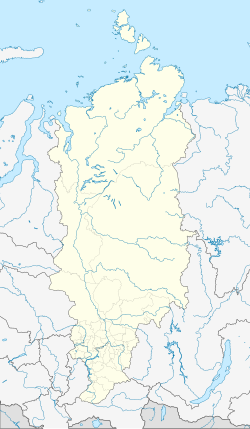Lessosibirsk
| city
Lessosibirsk
Лесосибирск
|
||||||||||||||||||||||||||||||||||||||
|
||||||||||||||||||||||||||||||||||||||
|
||||||||||||||||||||||||||||||||||||||
| List of cities in Russia | ||||||||||||||||||||||||||||||||||||||
Lessosibirsk ( Russian Лесосибирск ) is a Russian city with 61,139 inhabitants (as of October 14, 2010) in the Krasnoyarsk region in Siberia .
geography
The city is located on the Yenisei not far from the mouth of a tributary, the Angara , about 300 kilometers north of the regional capital Krasnoyarsk . Surrounded by the forests of the Siberian taiga, Lessosibirsk has a large sawmill. Lessosibirsk is located in the Angara lowlands and is part of the Central Siberian Plateau , a heavily divided area that is up to 500 meters above sea level. The climate is sharply continental with long harsh winters and warm short summers. Average temperatures are –22 ° C in winter and +16 to +18 ° C in summer.
history
Lessosibirsk (literally "wooden town in Siberia") was founded in 1975 through the merger of the two localities Maklakowo ( urban type settlement since 1953) and Nowomaklakowo (urban type settlement since 1966; name means "New Maklakowo"; about 5 km upstream / southeast) as Inland port city founded on the Yenisei. In 1989 the urban-type settlement Novojenisseisk (status since 1962, initially as Novojenisseiski; name means "New Jenisseisk " after the old town 20 km northwest; about 10 km downstream / northwest of the center of the former Maklakowo) was incorporated.
Population development
| year | Residents | annotation |
|---|---|---|
| 1959 | 16,262 | Maklakowo |
| 1970 | 36,408 | of which Maklakowo 17,228, Nowomaklakowo 7,798, Novojenisseiski 11,382 |
| 1979 | 56,196 | of which Lessosibirsk 38,625, Novojenisseisk 17,571 |
| 1989 | 68,349 | |
| 2002 | 65,374 | |
| 2010 | 61,139 |
Note: census data
economy
Lessosibirsk is considered to be the Russian “capital of the wood industry”: The city is based on a few dozen wood sawmills with an annual production volume of up to 3 million cubic meters of wood. The wood chemical industry is also represented and produces, among other things, cellulose , rosin and turpentine .
The training offer consists of a technical and pedagogical university, technical school, wood technology colleague, vocational school and art schools.
traffic
Lessosibirsk is the terminus of a railroad from Achinsk (a branch of the Trans-Siberian Railroad to the region to open up at kilometer 3914), which was originally built north of Achinsk for the timber industry. The city could be reached by night train from Krasnoyarsk via this until 2011, and by through coach until summer 2013 . Since then, there has only been a rare local train connection to Achinsk (as of April 2015).
Lessosibirsk can be reached by bus from Krasnoyarsk in around 4.5 hours. In the ice-free period, shipping on the Yenisei plays an important role, especially in freight traffic. Passenger ships need about 18 hours for the route.
Web links
- The city of Lessosibirsk
- Lessosibirsk on mojgorod.ru (Russian)
- Lessosibirsk on krasu.ru (Russian)
Individual evidence
- ↑ a b Itogi Vserossijskoj perepisi naselenija 2010 goda. Tom 1. Čislennostʹ i razmeščenie naselenija (Results of the All-Russian Census 2010. Volume 1. Number and distribution of the population). Tables 5 , pp. 12-209; 11 , pp. 312–979 (download from the website of the Federal Service for State Statistics of the Russian Federation)
- ↑ Information in the city portal (Russian)
- ↑ Travel report on Ostblog.org



